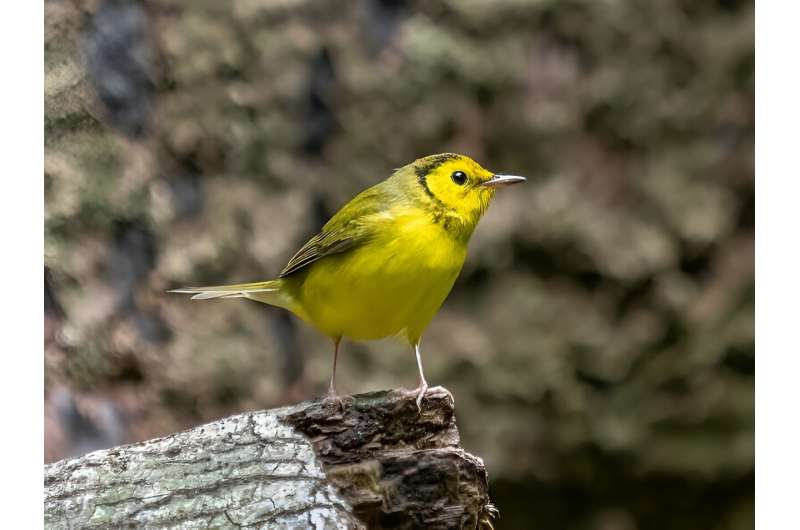This article has been reviewed according to Science X's editorial process and policies. Editors have highlighted the following attributes while ensuring the content's credibility:
fact-checked
peer-reviewed publication
trusted source
proofread
Migratory songbird study finds link between white tail spots and longevity

A new study of a migratory songbird shows that individuals with average-sized white tail spots—a trait that is critical to successful foraging—live longer than individuals with more extreme amounts of white in the tail.
The findings provide an infrequently observed example of stabilizing selection, whereby natural selection favors average individuals with traits that are close to the population mean.
The new research, published in Proceedings of the Royal Society B, focuses on the hooded warbler, a small migratory songbird that breeds in forested habitats in eastern North America and winters in southern Mexico, Central America and the Caribbean.
Throughout their complex migratory life cycle, hooded warblers employ an unusual feeding strategy called flush-pursuit foraging; by continuously flicking open their tails to reveal the white outer tail feathers, hooded warblers startle and flush winged insects that can then be pursued and captured in flight.
"We've known for some time that the white tail spots are important in hooded warbler foraging," says Professor Emeritus of Biology Ron Mumme of Allegheny College. "If you temporarily darken a bird's tail spots, foraging success drops substantially."
He also notes that there is strong experimental evidence from other species of flush-pursuit foragers that the extent of white in the tail is fine-tuned by natural selection; atypical tail patterns that depart from the population average are less effective at startling insect prey and lead to reduced foraging success.
"What we didn't previously know is whether natural variation in the extent of white in the tail affects long-term survival," Mumme says. "That's the question I wanted to answer."
Mumme addressed the question through his 14-year study of hooded warblers at Hemlock Hill Field Station in northwest Pennsylvania. From 2010 through 2023, he captured, color-banded, and measured the tail patterns of 625 hooded warblers that settled and bred at Hemlock Hill during the May–August nesting season. He then monitored the long-term survival of the color-banded birds that returned to the study site—or failed to return—in subsequent years.
First, he found that hooded warblers show considerable inter-individual variation in the extent of white in the tail that is highly repeatable across annual feather replacement that occurs during the late-summer molt; 75% of the variation in the extent of white is attributable to consistent differences among individuals, with only 25% attributable to annual changes within individuals.
"That's a very strong hint that the variation in tail pattern likely has an underlying genetic basis," Mumme says. He suspects that the plumage variation results from slight individual differences in how key feather coloration genes are regulated.
Second, while most hooded warblers had poor long-term survival and were present at Hemlock Hill for only 1–2 years, others were considerably more successful, surviving and returning to breed at Hemlock Hill for as many as nine consecutive seasons. That creates what evolutionary biologists call the 'opportunity for selection' to act on variation in traits that potentially affect survival.
Finally, long-term survival was not random with respect to tail white; birds with an intermediate extent of white—those that were close to the population average—lived longer than individuals with more extreme amounts of white in the tail. The results strongly suggest that the extent of white in the tail is fine-tuned by stabilizing natural selection to maximize both foraging success and long-term survival.
"It's a great example of how stabilizing selection can act on slight plumage variations that at first glance seem completely inconsequential," Mumme says.
More information: Ronald L. Mumme, Stabilizing selection on a plumage-based foraging adaptation: hooded warblers with average-sized white tail spots live longer, Proceedings of the Royal Society B: Biological Sciences (2023). DOI: 10.1098/rspb.2023.1752
Journal information: Proceedings of the Royal Society B
Provided by Allegheny College


















